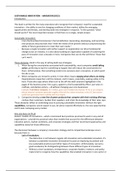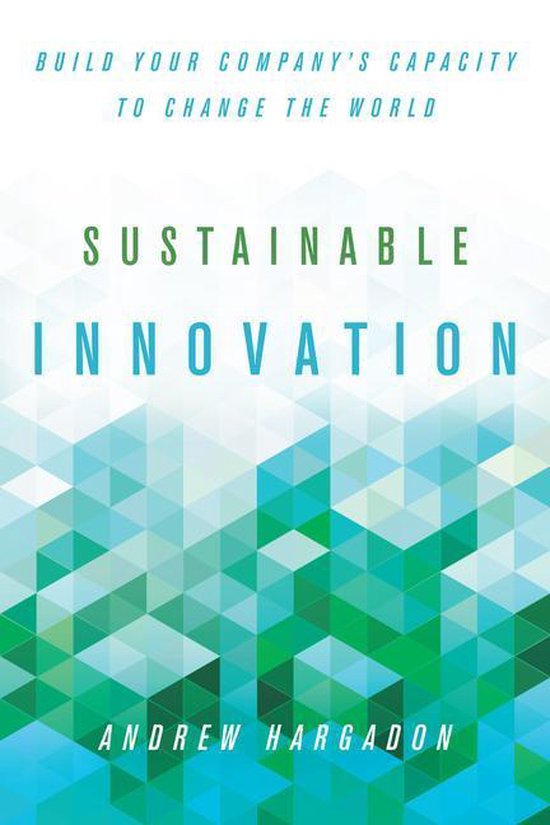SUSTAINABLE INNOVATION – HARGADON (2015)
Introduction
This book is written for the many executives who recognize their company’s need for sustainable
innovation – the ability to see the changing conditions of their market, define the emerging
opportunities and threats, and develop bold new strategies in response. To the question “what
should we do?” the most important answer is that there is no single, simple answer.
Sustainable innovation:
- From the Bruntland Commission’s formal definition: Generating, developing, and launching
new products and processes that “meet the needs of the present without compromising the
ability of future generations to meet their own needs.”
- Because a single innovation will neither support an organization nor drive fundamental
change across an industry, it is also about building an organization capable of sustaining the
pace of innovation over a decade or more. Companies that can do this will thrive’ those that
can’t won’t.
Three obstacles stand in the way of setting bold new strategies.
1. When facing the uncertainties associated with sustainability, most companies avoid taking
action, preferring to wait for something to happen that will reduce the uncertainties for
them. Unfortunately, that something tends to be someone else’s innovation, at which point
the die is cast.
2. When companies are moved to action, it most often means copying what others are doing.
Organizational researchers call this mimesis, and it means, essentially, seeking safety in the
herd. Those who copy others often turn to the off-the-shelf solutions highlighted in the
pages of the business press: hire a guru, appoint a chief sustainability officer, put solar on
rooftops, and declare victory – all without changing your core businesses.
Example: Ford Motor Company: $15 million, grass roof installed over factory à For a car company
whose industry’s products generate roughly a third of the carbon emissions in the US, few actions
could have generated more visibility with less impact.
3. Companies develop a new line of green products that compete with their existing offerings,
confuse their customers, burden their suppliers, and strain the knowledge of their sales reps.
These obstacles reflect an underlying issue in pursuing sustainable innovation: without the right
capabilities, companies cannot expect to see, let alone respond effectively to, the new opportunities
and threats reshaping every market.
One size does not fit all
Generic models of innovations – which recommend best practices promised to work in any and all
organizations – provide less practical value than models that account for the differences between
industrial sectors, market conditions, and corporate strategies and that recommend approaches and
capabilities based on those differences.
The disconnect between a company’s innovation strategy and its competitive landscape occurs
because there is:
- Lack of vocabulary
o The distinction is not between regular old innovation and sustainable innovation; it’s
between sustainable innovation (innovation focused on displacing incumbent and
less sustainable practices) and other types of innovation. Unfortunately, we lack a
good vocabulary for distinguishing between these different types of innovation.
o Without a clear vocabulary, entrepreneurs, corporate leaders, investors, and policy
makers fail to recognize how the capabilities that enabled innovation in one sector or
, one moment in time may not be as effective elsewhere or, worse, may undermine
efforts.
- Misleading (and misguided) approaches
o The second difficulty comes from mistaking invention for innovation, a misguided
approach that has challenged many recent efforts to pursue innovations in clean
energy.
- Hubris
o The third difficulty is hubris. Entrepreneurs and innovators alike, having found
success in one context, credit themselves over their circumstances.
o For example: the capabilities needed for the Internet revolution were not the same
ones needed to disrupt the centuries-old industries of energy, agriculture, and
transportation.
In the end, all innovation – developing and delivering something new – requires developing different
capabilities than you had before.
,SUSTAINABLE INNOVATION – HARGADON (2015)
Chapter 1: Sustainable Innovation
Long Fuse, Big Bang
From the past, we can learn valuable lessons about how change happens over time. Cycles of
innovation, for example, tend to have a long fuse and a big bang. Or as the late economist Rudi
Dornbusch noted, things take longer to happen than you think they will, and then they happen faster
than you thought they could.
Example: Electric lighting à In the first decade of the 1800s, European scientists began experimenting
with electric light. Two technologies quickly emerged (arc lighting, and incandescence). For the next 75
years or so, these technologies evolved in parallel and with almost no effect on business or society
until, in 1882, Edison turned on the Pearl Street Power Station in Manhattan. Within the next decade,
the modern utility model of electric power was born, along with the electric utility and equipment
companies that would dominate this sector for the next century.
Such periods of relative calm followed by revolutionary changes are more common than you might
think. That same pace of change describes the early days of the railroad, the automobile, and the
Internet.
- Railroad industry à Had been developing for half a century when the first commercially viable system
launched in 1830. Then, within less than two decades, it spread across Europe and the US.
- Automobile industry à First commercial automobiles emerged in the 1890s (led by Daimler,
Maybach, Benz). By the turn of the century, however, there were more electric- and steam-powered
cars than internal combustion engines, and the industry faced confusion and uncertainty over which
direction it was heading. à Ford’s Model T, introduced in 1908, marked a pivotal moment. In the
decade that followed, almost all the major American automobile manufacturers as well as their major
parts suppliers would be founded (including Chevrolet, Chrysler, Buick, Cadillac, and General Motors.
- Internet à born in the 1960s to connect mainframe computing resources on separate college
campuses, spent almost three decades evolving in universities and national laboratories before,
beginning in the mid 1990s, companies like Amazon, Google, and Facebook emerged to become
today’s consumer – and corporate-facing infrastructure.
The elements of Sustainability
In the last fifty years of the sustainability movement, elements have emerged that are setting the
stage for rapid changes within and across industries over the coming decades:
- Science has evolved
o The science of the effects of unsustainable practices includes our understanding of
climate change, ability to track greenhouse gas emissions and measure their impact,
and understanding of agriculture, nutrition, water use, and so many other aspects of
modern society.
o But more importantly for corporate leaders, it includes accepted theories and
standards for modeling and measuring the impacts and risks associated with
sustainability
§ For a long time, we’ve known that the assets of the natural environment
have value and, conversely, that their depletion has costs. But until we could
agree on how to predict and measure those assets and costs, it was difficult
to make decisions based on them. That has now begun to change.
§ Reaching consensus on sustainability metrics enables businesses to account
– as both assets and liabilities – for their relationship with the natural
environment. This practice will have significant impact as lenders, investors
and insurers make choices based on these accounts.
- New technologies have emerged and evolved
o The economics of clean energy technologies has improved to the point of competing
evenly with traditional (read carbon intensive) energy sources.
, - Other technologies have emerged (in addition to the usual clean technology suspects)
o From connected energy monitoring systems for home and business, such as Google’s
Nest, to the connected city and smart grid technologies offered by IBM, GE, and
other industrial giants, information and communications technologies and the
Internet have created entirely new opportunities for sustainable innovation.
o The Internet has also changed the market conditions for many companies by
providing the means for radical transparency (whether your company wants it or
not). Incidents that were, unfortunately, relatively common but went unnoticed now
can become overnight sensations and trigger rapid public outcry and policy
responses.
§ Environmental disasters like the ExxonMobil pipeline leak that spilled twelve
thousand barrels of crude oil in a suburban Arkansas neighborhood in 2013, or the
coal ash spill that sent eighty-two thousand tons of ash into the Dan River in North
Carolina in 2014.
- Customer values (whether individual or large corporations)
o What customers value influences what problems are solved by new combinations of
these technical possibilities. These values cut both ways:
§ On the one hand, they define what markets want and are willing to pay for.
Consumers and corporate buyers are increasingly deciding which products
they will buy and use on the basis of a set of defined economic,
environmental, and social values.
• For example, Walmart announced its goal of being powered 100 percent by
renewable energy, and McDonald’s announced its commitment to purchase
sustainable beef.
§ On the other hand, market preferences are also redefining what will no
longer be tolerated. This social contract reflects public opinion about what
companies should and should not be allowed to do.
• For example, you see the changing social contract at work with cigarette
companies that, in the 1960s, were making decisions about nicotine
content and marketing that are now so far out of favor as to be the subject
of billion-dollar lawsuits.
• The lenders, insurers, and lawyers of energy utilities are now asking
whether a coal plant will be an asset or a liability for the next twenty to
thirty years of its life.
o As the social contract changes, bolder government policies are not far behind, but
perhaps most influential of all are the voices of investors.
§ Sure, when individual and corporate customers start shifting their buying
preferences, companies notice. But when investors, lenders, and lawyers
start shifting their preferences, CEOs start to notice.
o The ultimate tipping point may still lie ahead the real shifts in consumer preferences
will come from those younger consumers who are just now acquiring purchase
power.
Together, these developments across science, technology, and markets converge in policy makers’
taking bolder steps toward reducing unsustainable practices. To prepare for these changes,
companies will need the right capabilities.
Right tools for the right job
The challenge for any leader is to build an organization able to thrive, or at least survive, when
change hits its markets, and that means ensuring it hast the right capabilities for innovation.
To understand why building an innovative organization is so hard, know that you cannot just add
new practices or people – or for that matter build a creative space, change the reward system, move
the chees, or hold an offsite – and expect innovation to suddenly flourish. To understand this, we
need to understand how people, practice, tools, organizational structures, resources, IT systems, and






